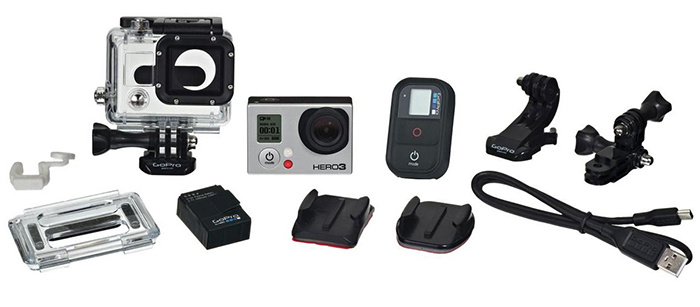GoPro

GoPro is an American brand of high-definition personal cameras, often used in extreme action video photography. They are known for being lightweight, rugged, wearable or mountable in unusual places such as outside planes, cars, boats or army tanks.
The company that develops, manufactures and markets the cameras and equipment is privately owned Woodman Labs based in San Mateo, California.
History
The company was formed by Nick Woodman. Woodman said he was inspired to start the company following a 2002 Australia surfing trip in which he was hoping to capture quality action photos of his surfing, but could not because amateur photographers could not get close enough, or obtain quality equipment at accessible prices. His desire for a camera system that could capture the professional angles inspired the 'GoPro' name. The parent company includes financing by several venture capital companies including Steamboat Ventures (affiliated with the Walt Disney Corporation), Riverwood Capital, Sageview Capital, Walden International, and U.S. Venture Partners.
Woodman initially raised money for his company by selling bead and shell belts out of his VW van. Each belt sold for under US$20. While making the belts, he came upon the idea of providing a fashionable strap to attach a camera. At the time most straps were rubber wrist straps that some reviewers found to be awkward, painful, or easily broken.
In 2004, the company sold its first camera system—a 35 mm film version. The cameras evolved, going from 35mm to digital, where it started recording 10-second clips, to 3-megapixel digital cameras, to its current configuration of fixed-lens HD video cameras with a 170-degree angle. Two cameras can now be paired together to create 3D video. The cameras have branched out from the surf crowd to be used for auto racing, skiing, and bicycling as new adapters are created.
Corporate actions
On March 30, 2011, GoPro acquired CineForm. In particular, the acquisition brought the CineForm 444 Codec into its control. The codec (which was used in the film Slumdog Millionaire) according to the press release "makes HD and 3D editing faster and more convenient without sacrificing image quality". It was used to roll out the 3D HERO® System shortly after the acquisition.
In March 2013, GoPro issued a DMCA takedown notice to a site (Digitalrev.com) that had posted a review of its product, citing trademark use as a breach of copyright. This notice was retracted 10 days later citing "erroneous enforcement".
HD HERO cameras
GoPro sells three fixed-lens cameras, all without viewfinders. A 2-bit LCD on the front of the camera allows access to its menu system, which is controlled with the front and top shutter buttons. The cameras have dimensions of 1.6” x 2.4” x 1.2” (42mm x 60mm x 30mm) (HERO2). The range for capturing still images is 5 to 12 megapixels. The cameras are bundled with a clear polycarbonate HD Housing (with glass lens) that is rated shockproof and waterproof to 180 ft/60 meters. The housing consists of a quick-release buckle on the top and threads at the bottom which can be used with a special screw to connect to all of the GoPro mounts. The housing has metal buttons which are synched to connect to the camera's controls. The housing has a "skeleton" backdoor option to allow better capture of audio in situations where it is not necessary for the camera to be water tight or shock proof (but wishing to take advantage of the mounts)
In addition to the usual camera features, the cameras also include an upside down mode to make the photo/video appear upright when played; interval shooting of every 2, 5, 10, 30 or 60 seconds allowing the camera to continuously shoot unattended; 3 photo burst; and self-timer. The camera spec sheet notes they have a proprietary 1050 mAh lithium-ion battery (HERO3), Aperture: f/2.8, and rated >1.4 V/lux-sec in video mode.
Products
HERO3+
In October 2013, GoPro released the HERO3+, available in Black Edition and Silver Edition, which replaced their respective Hero3 generation predecessors. The Hero3 White Edition still remained as the actual model in the low-end GoPro's device segment.
Both Hero3+ camera models have "dramatically improved" low light performance, and a new waterproof enclosure which is lighter and smaller than the HERO3 (20% and 15% respectively, according to the GoPro website - the Hero3+ camera itself has a 20% decrease in size compared to the Hero3) and are also claimed to have improvements in image sharpness (close focus down to 7" vs about 3 ft on the Hero3, at the expense of distant focus which is slightly less sharp with Hero3+), and better audio functionality to include wind noise rejection. Battery runtime improvement is claimed to be 30% compared to the respective Hero3 model (both through better efficiency and a higher capacity battery in the same size).
The Black Edition has video modes of 1440p48, 1080p60, 960p100 and 720p120 as well as 4Kp15 and 2.7Kp30 and can shoot 12MP stills at up to 30 frames per second. Along with the increased resolution, the HERO3+ Black Edition also features a function in firmware (called "SuperView") which additionally increases the field of view, and its activation is optional. It has additional "enterprise" functions, such as dynamic low light situation adjustment, professional recording modes (higher bitrates, no white balance applied, etc.) etc. The Black Edition continues to include a Wifi Remote. The Black Edition does not have the ability to record 25/30 FPS in 720p and WVGA modes (it can only record at very fast framerates in those lower resolutions). This is a deliberate firmware limitation, as the manufacturer does not expect this high-end product to be used for recording in such "low" resolutions with so "low" framerates. The battery runtime of Hero3+ Black Edition, although significantly longer than Hero3 Black Edition, is still around 30-50% lower than the battery runtime of Hero2 and Hero1, which are two and three generations older, respectively.
The Silver Edition has video modes of 1080p60 and 720p120 and can shoot 10MP stills at up to 10 frames per second. In contrast to the Black Edition, the Silver Edition can record at 25/30 FPS (or higher) in all supported resolutions. Hero3+ Silver Edition also has about 25%-50% longer battery runtime during recording than Hero3+ Black Edition (they both use the same batteries). The difference in runtime depends on the resolution/FPS combination, and whether WiFi and GoPro mobile application are used during recording. The difference in runtime increases as the FPS is lowered and the additional functions are deactivated on both cameras. The battery runtime of Hero3+ Silver Edition is similar to the battery runtime of Hero2 and Hero1.
HERO3
In late 2012, GoPro announced the Hero 3 line of cameras. These new cameras came in three editions: Black, Silver, and White.
All three versions of the Hero3 come in a new 30% smaller and 25% lighter package, with WiFi functionality built in. The change of the physical dimensions of the cameras compared to the previous generations (Hero1 and Hero 2 were physically identical) implicates that some of the camera accessories for Hero1 and Hero2 are not compatible with Hero3, so GoPro made new versions of those accessories specifically for Hero3 (and mostly for Hero3+, see above). Those new versions of accessories are usually not compatible with older Hero camera generations. However, a lot of other accessories are compatible with all HD Hero camera generations.
One notable disadvantage of Hero3 Silver and Black cameras (compared to Hero1 and Hero2 cameras) is significantly shorter battery runtimes. For example, in 720p resolution with 25/30 FPS, while Hero1 and Hero2 have a stated battery runtime of 3 hours, Hero3 Silver Edition has a stated battery runtime of 2 hours, while Hero3 Black Edition has a stated battery runtime of only 1.5 hours (the Black Edition's "most economical" setting is 1080p/30 FPS, so this also partially contributes to its poor battery runtime).
The Black Edition features a new 12 MP sensor that is capable of capturing 4K digital video at 15 fps, 2.7K video at 30 fps, 1440p at 48 fps, 1080p at 60fps, 960p at 100fps, 720p at 120 fps and WVGA at 240 fps. The Black edition also includes the Wifi Remote. The Black Edition can not record at 25/30 FPS in 720p and WVGA resolutions . It can record only at very fast framerates in those resolutions. This is a deliberate firmware limitation, as the manufacturer does not expect that this high-end camera model will be used in such "low" resolutions with so "low" frame rates.
The Silver Edition uses the same 11 MP sensor as the Hero2.
The White edition uses the same 5 MP sensor as the HD Hero1.
HD HERO2
The HD HERO2 was launched on October 24, 2011. It has an 11 MP image sensor, improved low-light capability and records at up to 120 frames per second. It was sold with three different accessory packages: Outdoor Edition, Motorsports Edition, and Surf Edition.
HD HERO
The HD HERO Naked, released with a range of accessories, shoots a maximum of 1080p video on its 5Mp sensor. The Naked camera line forms the basis for other bundles which are differentiated by the types of mounts they have (HD Helmet HERO, HD Motorsports HERO, HD Surf HERO). It was first listed on January 25, 2010.
Specifications
- Sensor size : 1/2.5-inch - 5.75 × 4.28 mm
- Pixel size : 2.2 μm
- Image format :
| Mode | Size | fps | FOV |
|---|---|---|---|
| R1 | 848 × 480 | 60 | 170° |
| R2 | 1280 × 720 | 30 | 170° |
| R3 | 1280 × 720 | 60 | 170° |
| R4 | 1280 × 960 | 30 | 170° |
| R5 | 1920 × 1080 | 30 | 127° |
| Photo | 2592 × 1944 | 0 | 170° |
HD HERO 960
HD HERO 960 - shoots a maximum of 960p video and is not compatible with GoPro's electronic accessories although the camera is compatible with all GoPro mounts. It was first listed on August 6, 2010
Digital HERO 5
The Digital HERO 5 (first introduced on December 5, 2008) had a 5-megapixel still photo sensor, and supported standard definition (512x384) video capture. It ran on two AAA batteries, had 16 MB of internal memory, and could function with a 2 GB SD card. It was the first GoPro HERO camera to use a 170° angle of view, ultra-wide lens. Its housing was aggressively—and extraordinarily—rated to 100 ft/30 meters depth. Its dimensions were 2.6 x 1.75 x 1.25 inches (66.04 x 44.45 x 31.75mm). The camera is not designed to work with the newer HD HERO line of housings, although the standard screw mounts are indeed compatible.
Digital HERO 3
The Digital HERO 3 released in 2007 had a 3-megapixel camera and shot standard definition 512 × 384 video. It was rated up to 30 meters (98.4 feet) in depth.
GoPro HERO 35mm, All-Season Sports Camera
The 35mm camera (model #001) became available on April 13, 2005. It had dimensions of 2.5 by 3 inches (64 by 76 mm) and weighed 0.45 pounds (200 g). It included the camera, a clear case with quick release, a camera strap, and ski glove adapter lash. It could pivot "on the fly" and was functional to a depth in water of about 15 feet (5 m). It was described as a "reusable wrist camera" and included a roll of 24 exposure Kodak 400 film.










